Long Creek Nursery is Ready to Share It’s Abundance!

After many years of gathering and trialing useful and fruitful plants from around the world we have created an ‘Edible Landscape Allstars’ collection for our region. Our Allstar selections have proven to be easy to grow, disease resistant, productive, and attractive in the Mid-Atlantic region.
We know our plants, which means you not only get an appropriate selection but first hand knowledge in their preferences and care.
We Love Paw Paws & Chestnuts and Persimmons & we have the Best Genetics
Our Chestnuts are..
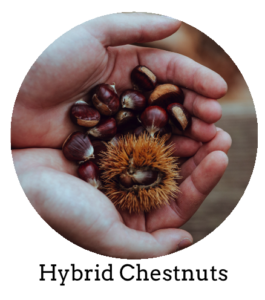
Amazingly productive, disease resistant, fast growing, and gorgeous landscape trees. Trees reach an average of 30-40′ with a beautiful umbrella shaped crown. Expect nuts to begin growing at age 6 and continuing for hundreds of years! A true legacy. Need minimum 2 for cross pollination. 20-40′ spacing.
By appointment for large orders.
Address: 8955 Indian Springs Rd Frederick MD 21702.
*GPS may bring you down either of our gravel lanes that open out into wide circle drive in front of a large brick house, the nursery is in front of the house in the old barn foundation.
240-344-5625.
No mailing.
Pre Orders most welcome.
Peruse the listings below and email your order or request to info@ecologiadesign.com.
***Please respect that we are not available to answer inquisitive emails about plants, as much as we love talking about them we are usually out and about. Check out the plant info below.
2025 Catalog
Bareroot/Potted:
Click here to learn about Mike’s Select PawPaw Seedlings.
$40 – Mike’s Select PawPaw Seedlings – 2nd year 6-8″
$20 – rooted ‘Winters Glory’ Willow
$20 – Select Black Currant (See Cuttings)
$35 – Select Hybrid Chestnut (6 or more at $30 each, 10 or more $25 each)
$30 – Nanking Bush Cherry
$30 – Goumi ‘Sweet Scarlet’
$35 – Gooseberry
$25 – Juneberry alnifolia
$20 – Flying Dragon Citrus 6-8″ (Deer Proof)
$30 – Select American Elderberry
$15 – Indigo Bush – Amorpha fruticosa – Nitrogen fixer/Pollinator (Deer Proof)
Cuttings/Divisions:
$20 – Lemon Balm (Deer Proof)
$20 – Black Currant Cuttings (4)
$20 – Cuban Mojito Mint (Deer Proof)
$20 – Comfrey – Running & Standing
$20 – Mountain Mint – Awesome Pollinator! (Deer Proof)
$20 – Nettles
$20 – Chives – (Deer Proof)
$20 – Fuki – Perennial Japanese Vegetable (Deer Proof)
$25 – Edible Bamboo var. P. Dulcis (Deer Proof)
$25 – Timber Bamboo
$45 – Oyster Mushroom Log
About Long Creek’s Stock
Salix ‘Winter Glory’
(gracilistyla x caprea = Salix x leucopithecia)
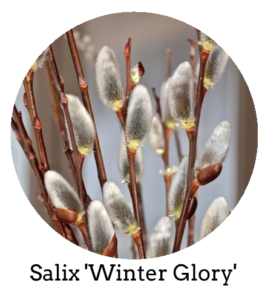
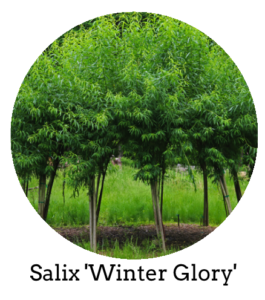
This is the amazing willow we use for living domes, tunnels, arches, fences, tee pees, windbreak, stand alone specimen, etc. fast growing, disease resistant, vibrant, beautiful catkins.. our favorite.
This gorgeous Japanese hybrid forms a small tree from 15-20ft with large green leaves that are silky underneath. It has some of the largest catkins in the genus and are much-prized as cut flowers. In Autumn they develop scarlet-red flower buds in the axils of the leaves and in sun start opening in October without damage over winter! They start to open fully in mild days in early February. They are soft, silky and pinkish-silver at first and grow to 3in long; this is a male form with catkins that turn golden with pollen. A non-fussy small tree that will grow anywhere in full sun with sandy, average or moist soil.
Note that we have rooted 8’+ plants for an extra quick jump start to a living structure or just as a specimen tree. Also in late winter/early spring we have many 8’+ whips which can be stuck in the ground 12” deep and will root right away. Being 8’+ mean that the deer cannot reach the upper parts so no fencing is required – though wrapping some chicken wire around them in winter is good to keep deer from rubbing their horns on young trees.
For a full sized 16’ diameter dome you will need 36 plants or whips, half as many for a smaller 8’ diameter dome, an archway could use anywhere from 8-24, tunnel 24-100+, living fence/hedge 10-100+, tee pee approx. 20.
Comfrey
Symphytum
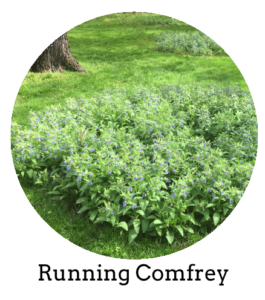
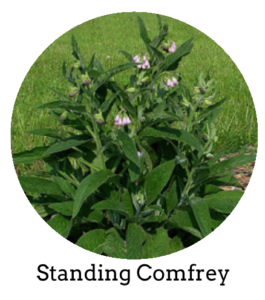
We grow and sell two types of comfrey at Long Creek Homestead; stand-alone and running.
Most folks are familiar with the stand-alone comfrey, sometimes called Russian comfrey, that is a beautiful large lobed leaved soft perennial that grows quickly to about 3-4’ high and has profusions of purple flowers that bees love. The deep tap roots of this comfrey mine minerals and other nutrients from deep in the soil and bring up into their lush leaves making it a great mulch and fertilizer plant, what in permaculture we call a dynamic accumulator. Generally the seed is sterile and the main way to propagate is by root chunks that will quickly sprout and grow. We typically just sell root chunks vs potted plants.
Running comfrey ‘Hidcote’ is not as well know but is quickly becoming popular as a dominant ground cover* where help is needed to keep down weeds while achieving a beautiful green mulch that flowers profusely. We use the running comfrey extensively at Long Creek Homestead around our trees and shrubs. In full sun the running comfrey will reach about 20-24” in height and spread many feet a year.
*Ground covers are great service providers, as they prevent erosion, weeds, and moisture loss while promoting diversity.
These spreaders can do a lot of work for you by colonizing open ground that otherwise would need to be managed for weeds. The process of ground cover plants growing and dying back each season “pulses” soil growth by adding organic matter above and below the surface, while creating food and shelter for soil biota. You can speed up the natural pulsing process by chopping and dropping the plants just after flowering. Many ground covers, such as mints and comfrey, also double as important pollinators for bees and other beneficial insects.
I have roughly three acres of established food forests with around 100+ trees that require very little of my time. This is in large part due to my extensive use of ground covers. Where I have successfully established ground covers—and where I have not—becomes quickly evident by the amount of labor I have to put in. In areas with significant ground cover, I have very low weed management needs. The downside of many ground covers is that you lose some diversity by having only one or two plant varieties versus filling the space with multiple companion plants. I find ground covers are best suited to larger landscape designs, or for those who have little time and interest to manage an array of plants.
Currants: Compact and Flavor Packed (sold out)
Ribes nigrum
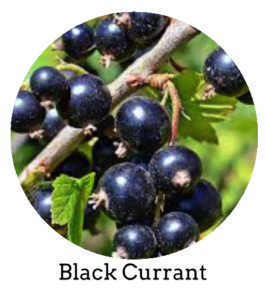 Currants are a stately bush of upright canes, attractive leaves, and fruits like dangling pearls that are beauties in any edible landscape. They are a European and Russian favorite that bursts with flavor and tremendous aroma. These qualities make them ideal for jam and wine making.
Currants are a stately bush of upright canes, attractive leaves, and fruits like dangling pearls that are beauties in any edible landscape. They are a European and Russian favorite that bursts with flavor and tremendous aroma. These qualities make them ideal for jam and wine making.
Similar in size to the gooseberry but thornless and erect in growth, usually between 3 – 5 feet, they blend in nicely at the shrub layer around trees, foundation plantings, and next to evergreens. I plant them between and around fruit trees where they get just enough light to fruit (6 hours) and stay cool in our hot Mid-Atlantic summers. There are black, red, white, and pink types of currants that go from very tart to sweet respectively. Aside from their intense flavor, the currant boasts five times the vitamin C of oranges by weight, as well as twice the potassium of bananas and antioxidants of blueberries. Our selections are the easiest cultivars to grow in the Mid-Atlantic. Self fertile. The Savannah Institute has a short video on them, http://Black Currant Video, plus resources for them as a perennial crop.
Aronia: Medicinal Wonderberry (SOLD OUT)
Aronia melanocarpa
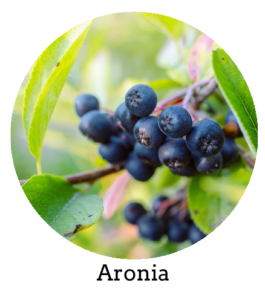
The black aronia is an ornamental shrub that boasts a handsome upright habit, creamy white flowers, red flame autumn foliage, and abundant dark berries. It is very excepting of challenging site conditions and easy to harvest. High in antioxidants, polyphenols, minerals and vitamins you can see how this edible landscape allstar earns the name wonderberry!
Mature plants reach about 8 feet tall and 4 – 5 feet wide, make great foundation plantings or an attractive fedge (fruiting hedge). Large droops of hanging berries ripen in August, are easy to pick, and not favored by birds, offering an easy harvest period.
Berries need to be steamed/cooked to extract the deep rich berry flavors within. If eaten raw you will quickly learn why it is commonly called chokeberry! The extracted juice makes excellent jelly, wine, cocktail syrups, sorbet, and growing popular as a hard apple cider additive.
Our family’s favorite use of aronia is to make a juice with elderberries and goumi berries for tasty healthy smoothies and frozen popsicles. The cultivars “Viking” and “Nero” are recommended. Self fertile.
Nanking Bush Cherry
Prunus tomentosa
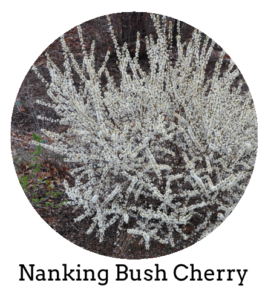
Cherries on a bush! One of our favorites edible landscaping plants at Long Creek Homestead for its picturesque shrub form, early pure white flowers, and tasty sweet/tart fruits. Winter hardy and grows moderately fast, reaching about 5-6’ tall. Ideally grown in full sun. Great for fresh eating, processing into wine, syrup, jellies, etc. Can be planted en masse for a windbreak, screen and fedge(fruiting hedge). One challenge is that if there is a late frost the flowers can be killed and little to no fruit that year. Also provides fruit and nesting for song birds. Ideally have two or more for best fruit set.
American Elderberry
Sambucus canadensis
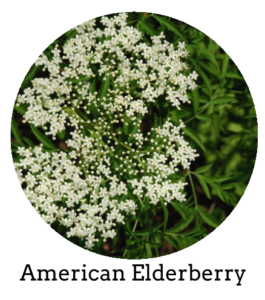
The American elderberry is a phenomenal plant that grows very quickly and producers a profusion of medicinal flowers and fruit. Probably the fastest growing shrub we have at Long Creek Homestead – it can shoot stems 6-10’ high in a season! If you are looking for a fast tough growing plant that will fruit within 1-2 years look no further.
Average height is 8-10’ tall and wide. Typically, you need two for best fruit set. Will tolerates wet sites. Fruits best in full sun but will grow in partial light. Fruits are borne on 1- and 2-year-old wood so prune out stems that are over two years old to maintain best health and productivity. We offer the best-known American cultivars and do not recommend the European elderberries for our climate as they easily succumb to disease.
Red Stem Willow (sold out)
Salix x fragilis f. vitellina ‘Britzensis’
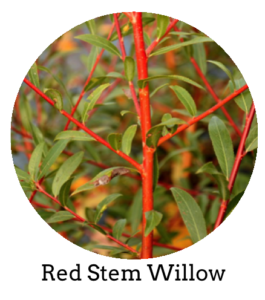 Our brightest red stemmed willow at Long Creek Homestead. This beautiful willow has many locations on our homestead as it gives year-round interest. It grows as an upright, medium sized tree, but much better if coppiced or pollarded*. Will grows in most soils. Outstanding for winter color in a vase, container or in the garden. Best if coppiced/pollarded yearly as the young stems have the most color. Can be cut and dried for basket making and other objet d’art.
Our brightest red stemmed willow at Long Creek Homestead. This beautiful willow has many locations on our homestead as it gives year-round interest. It grows as an upright, medium sized tree, but much better if coppiced or pollarded*. Will grows in most soils. Outstanding for winter color in a vase, container or in the garden. Best if coppiced/pollarded yearly as the young stems have the most color. Can be cut and dried for basket making and other objet d’art.
*Coppicing and pollarding is extremely hard pruning to get the plant to produce an abundance of young shoots in order to produce the most flower buds and brightest colored stems. These are best performed in late winter before leaf buds start to turn green. The difference between them is that coppicing is where the stems are cut to 1-2in just above soil level, whereas pollarding is done on top of a straight 4-8ft trunk or on the top of shortened branches. Since we have an abundance if deer here at Long Creek Homestead, we pollard our willows just out our browse reach and are rewarded with colorful shoots every year.
‘Scarlet Curls Willow’ (sold out)
Salix x pendulina f. erythroflexousa
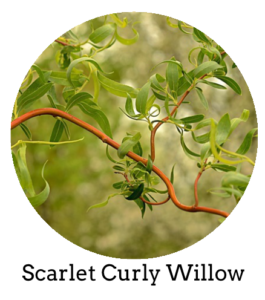 This is a show-piece plant here at Long Creek Homestead where it graces our nursery as an artful shade for our plants and by our strawbale home with year-long interest from the shining copper-red twisted stems. Grows 15-25ft tall with upright trunks, and branches that twist in many directions. Grows well in average soil and full sun, and can be pruned to keep it smaller. Can also be coppiced to produce great cut stems for flower arrangements, and used to create original and unique baskets!
This is a show-piece plant here at Long Creek Homestead where it graces our nursery as an artful shade for our plants and by our strawbale home with year-long interest from the shining copper-red twisted stems. Grows 15-25ft tall with upright trunks, and branches that twist in many directions. Grows well in average soil and full sun, and can be pruned to keep it smaller. Can also be coppiced to produce great cut stems for flower arrangements, and used to create original and unique baskets!
Hybrid Chestnuts
Castanea Spp. Hybrids

Amazingly productive, disease resistant, fast growing, and gorgeous landscape trees. Our hybrid chestnuts have the best genetics from the best research projects in the country. Note these are not American chestnut breeding program trees, but rather highly productive annual bearers of large delicious nuts! You want to have these growing near you. Trees reach an average of 30-40′ with a beautiful umbrella shaped crown. Expect nuts to begin growing at age 6 and continuing for hundreds of years! A true legacy. Need minimum 2 for cross pollination. 20-40′ spacing.
Juneberry
Amelanchier alnifolia
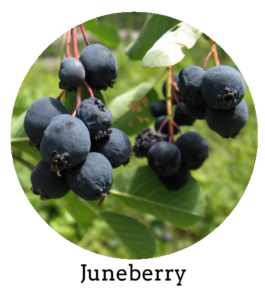
There are many types of Juneberry’s – all great – but we grow the alinfolia species as it is a superb producer of super tasty fruits on a small shrub/tree approx. 10-12′ tall. Lovely white spring flowers turn into blueberry like fruits that are delectable and ready in June! Pretty branching habit and brilliant orange/red fall colors.
Caring for Your Nursery Plants
Bigger Is not Better:
Why planting young and small is important for fruit trees & bushes.
When purchasing fruit trees and bushes look for small and young. Really you are shopping for root health.
For optimal plant health roots should never be compromised by becoming root bound in pots or dug large. What is common to find in the nursery industry these days are large perennials grown in small pots with added fertilizer to compensate for restricted roots. Alternately, when large trees and bushes are dug their root mass is dramatically severed, compromising the long-term health of the pant – no es Bueno.
So What to Look For?
Young plants in adequate pots with loose and spread out roots – always having nutrient and moisture available. This is typically only possible with fruit trees and bushes one or two years old. Three years onwards often brings root restriction and stress that will effect the long term health of that plant – its ability to resist stresses such as drought, disease, and insect imbalances.
Having a healthy soil medium in the pot also helps enormously with good plant establishment. Most commercial potted plants are a sterile peat mix with slow release fertilizer – and is certainly not rearing those babies for the conditions it’s going to find in your landscape. Since most fruit trees evolved from woodland systems look for fungal rich soil mediums and inoculants.
Young bare root plants offer a diverse window of opportunity for healthy plant establishment when timed well. Bare root plants are dug while dormant in fall and late winter and shortly thereafter replanted while still dormant. Bare root plants usually offer the best root systems as they have been grown outside in real soil and rain, they have natural unheeded vigor. If dug carefully when young they can have vibrant intact root systems. Look and ask for small diameter caliber on your single truck trees, half inch or less.
Planting while dormant or soon after growth begins helps the plants establish with minimal stress which translates into fruitfull harvest. So, now is the time to plant!!
Happy Planting,
Michael
P.s. To learn more visit our Food Forests post.
Posted In: Edible and Ecological Landscape Design

Lillian Book
·
I would like to purchase the Food Forest Bundle x 2. I have already purchased the book on PawPaws by Michael so maybe substitute his other book or just leave off. However we cannot pick up until the 17th or 18th. Would it be possible to pick up at the PawPaw festival? We will be driving from Fredericksburg, VA.
I can pay by PayPal or Venmo in advance.